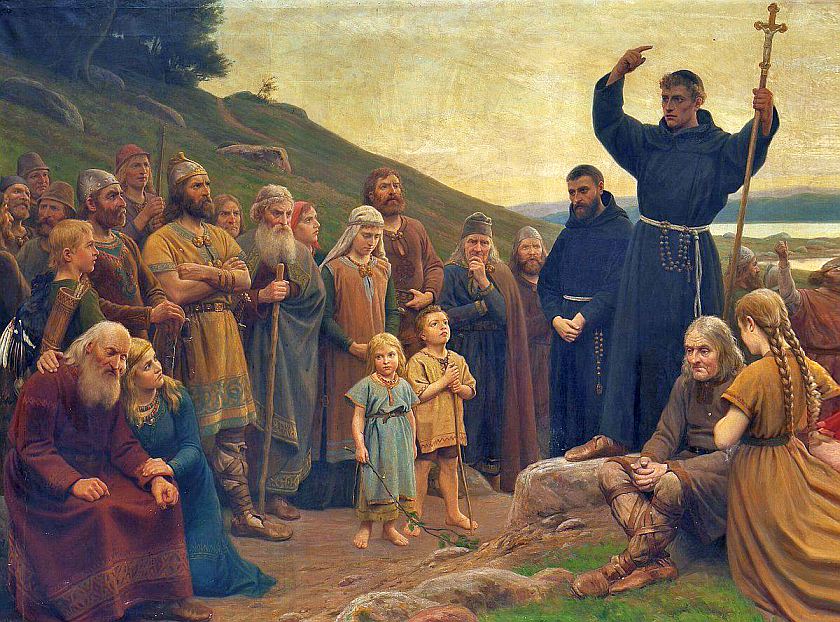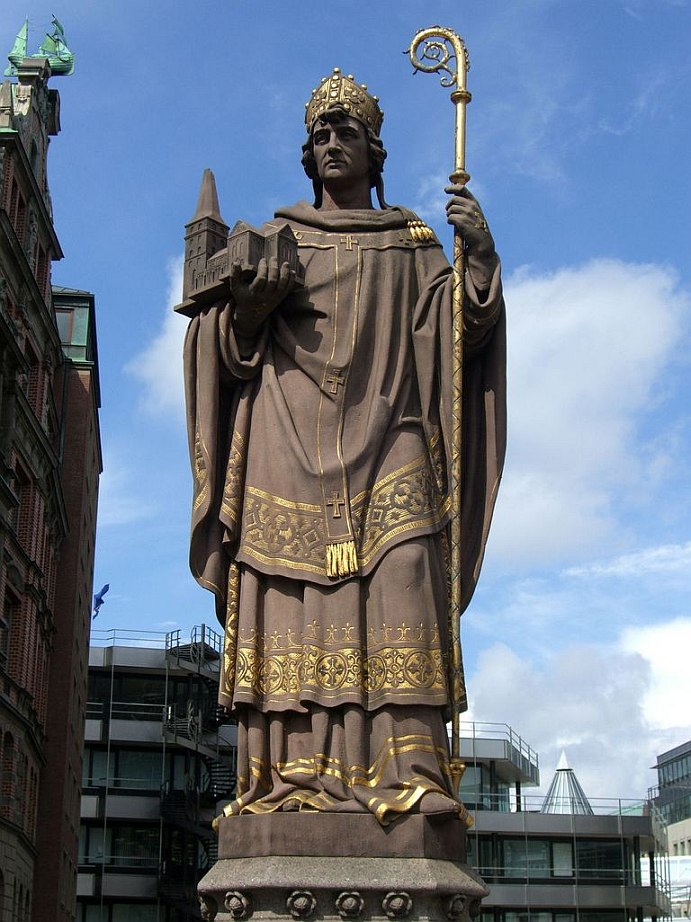

St. Ansgar (or Anscharius) was a monk, first of Corbie in France, afterwards of Corvey in Saxony. Harold, Prince of Denmark, having been baptized in the court of the Emperor Louis the Pious (also called Louis the Debonair, son of Charlemagne), St. Ansgar preached the Faith with great success, first to the Danes, afterwards to the Swedes, and lastly in Northern Germany. In 832 he was made Archbishop of Hamburg and Legate of the Holy See by Pope Gregory IV. Hamburg was burnt by an army of Normans in 845. The Saint continued to support his desolate churches till, in 849, the See of Bremen becoming vacant, Pope Nicholas united it to that of Hamburg, and appointed him Archbishop of both. Denmark and Sweden had relapsed into idolatry, notwithstanding the labors of many apostolic missionaries of Corvey, left there by our Saint.
 His presence soon made the Faith flourish again in Denmark, under the protection of King Horik. But in Sweden the
superstitious King Olas cast lots whether he should be admitted or not. St. Ansgar, grieved to see the cause of God
committed to the cast of a die, recommended the issue to the care of Heaven. The lot proved favorable, and the
Archbishop converted many of the lower rank, and established many churches there, which he left under the care
of zealous pastors at his return to Bremen.
His presence soon made the Faith flourish again in Denmark, under the protection of King Horik. But in Sweden the
superstitious King Olas cast lots whether he should be admitted or not. St. Ansgar, grieved to see the cause of God
committed to the cast of a die, recommended the issue to the care of Heaven. The lot proved favorable, and the
Archbishop converted many of the lower rank, and established many churches there, which he left under the care
of zealous pastors at his return to Bremen.
St. Ansgar wore a rough hair shirt and, while his health permitted, contented himself with a small quantity of bread and water. He never undertook anything without first recommending it to God by earnest prayer, and had an extraordinary talent for preaching. His charity to the poor had no bounds; he washed their feet, and waited on them at table. He ascribed it to his sins that he never met with the glory of martyrdom in all that he had suffered for the Faith. To excite himself to compunction and devotion in the divine praise, he made a collection of moving sentences, some of which he placed at the end of each psalm; many of these are found in certain handwritten psalters. The learned Fabricius, in his Latin Library of the Middle Ages, calls them an illustrious monument to the piety of this holy Prelate.
St. Ansgar died at Bremen in the year 865 – the sixty-seventh of his age and the thirty-fourth of his episcopal dignity; and was honored with miracles. In a letter which he signed with the German form of his name, Ansgar, he attributes all the fruits and glory of the conversion of the Northern European nations, to which he preached, to the zeal of Emperor Louis the Pious and of that Emperor's councilor, Ebbo Archbishop of Rheims, without taking the least notice of himself or his own labors. He compiled the Life of St. Willehad, the first Bishop of Bremen, who died in 789 – a judicious and elegant work; the preface which he wrote is a masterpiece for that age.
St. Rembert was a native of Flanders, near Bruges, and a monk in the neighboring monastery of Torhout.
St. Ansgar called him back to his assistance in his missionary labors, and in his last illness recommended him for his successor,
saying: Rembert is more worthy to be Archbishop than I to be his deacon.
After St. Ansgar's death in 865,
St. Rembert was unanimously chosen to be Archbishop of Hamburg and Bremen, and superintended all the churches of Sweden,
Denmark, and Northern Germany – finishing the work of their conversion. He also began the conversion of the Slavs living
in what is now the German state of Brandenburg (which surrounds the city-state of Berlin.)
He sometimes had to sell sacred vessels in order to redeem captives from the Normans. Once he even gave the horse on which he was riding to ransom a virgin taken by the Slavs. He was most careful never to lose a moment of time from serious duties and prayer, and never to interrupt the attention of his mind to God in the midst of his exterior functions.
He died on June 11, 888, but is commemorated in the Roman Martyrology on February 4 – the day on which he was chosen Archbishop. He wrote the Life of St. Ansgar, which is admired both for the author's accuracy and piety, as well as for the elegance and correctness of his composition. His letter to the Abbess Walburga is a moving exhortation to humility and virginity.
Alphabetical Index; Calendar List of Saints
Contact us: smr@salvemariaregina.info
Visit also: www.marienfried.com